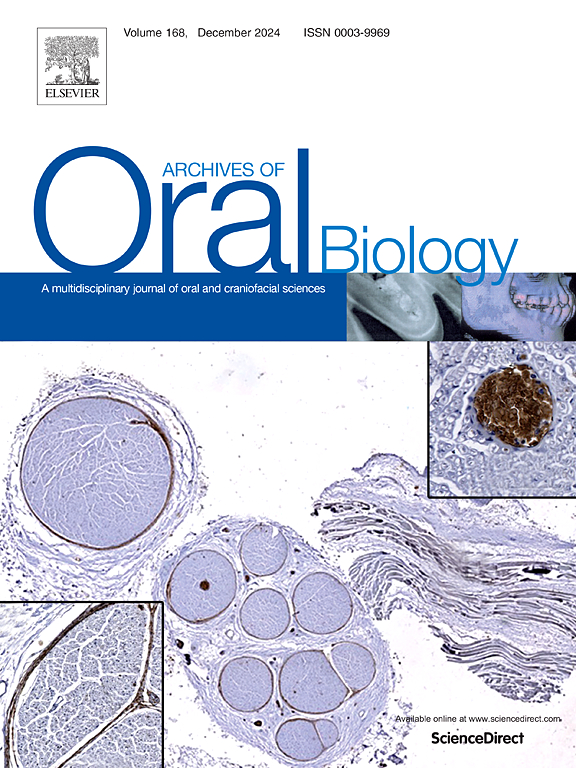The role of IL1β, IL6, and IL10 genetic variants in susceptibility to recurrent aphthous stomatitis: A systematic review and bioinformatics approach
IF 2.1
4区 医学
Q2 DENTISTRY, ORAL SURGERY & MEDICINE
引用次数: 0
Abstract
Objective
Recurrent aphthous stomatitis (RAS) is a common inflammatory condition of the oral mucosa with a multifactorial etiology, in which cytokine dysregulation is believed to play a central role. However, studies evaluating interleukin (IL)-1β, IL-6, and IL-10 levels and their genetic variants in RAS have yielded inconsistent results, likely due to population heterogeneity and methodological differences.
Materials and methods
This systematic review synthesizes current evidence on the association between single nucleotide polymorphisms (SNPs) of IL1β, IL6, and IL10 and susceptibility to RAS.
Result
Population-based studies and meta-analyses identified recurrent associations involving IL1β (rs1143634, rs16944), IL6 (rs1800795), and IL10 (rs1800896, rs1800872), although results varied across ethnic groups. These genetic variants may influence cytokine expression or secretion, thereby shaping the inflammatory response. Complementary bioinformatics analyses revealed rare missense variants—IL1β (rs1558783084, rs1273629321), IL6 (rs569143621, rs767924065), and IL10 (rs1674874269, rs1674734957)—with high predicted pathogenicity scores (cumulative score 4–5), yet exceedingly low allele frequencies (AF < 0.0001) in global datasets.
Conclusion
These findings highlight the complex interplay between genetic predisposition and population-specific factors in RAS. Further large-scale, multiethnic studies integrating functional validation are required to elucidate the precise contribution of cytokine gene variants to disease pathogenesis.
il - 1β、il - 6和il - 10基因变异在复发性口腔炎易感性中的作用:系统综述和生物信息学方法
目的当前口腔溃疡性口炎是一种常见的口腔黏膜炎症,具有多因素病因,细胞因子失调被认为在其中起核心作用。然而,评估白细胞介素(IL)-1β、IL-6和IL-10水平及其在RAS中的遗传变异的研究得出了不一致的结果,可能是由于群体异质性和方法差异。材料和方法本系统综述综合了目前关于il - 1β、il - 6和il - 10单核苷酸多态性(snp)与RAS易感性之间关系的证据。基于人群的研究和荟萃分析确定了与il - 1β (rs1143634, rs16944), il - 6 (rs1800795)和il - 10 (rs1800896, rs1800872)的复发相关,尽管结果在不同种族之间存在差异。这些基因变异可能影响细胞因子的表达或分泌,从而形成炎症反应。补充生物信息学分析显示,罕见的错配变异- il1 β (rs1558783084, rs1273629321), IL6 (rss569143621, rs767924065)和IL10 (rs1674874269, rs1674734957) -具有高预测致病性评分(累积评分4-5),但等位基因频率极低(AF <;0.0001)。结论RAS的遗传易感性与人群特异性因素之间存在复杂的相互作用。需要进一步的大规模、多民族研究整合功能验证来阐明细胞因子基因变异对疾病发病机制的精确贡献。
本文章由计算机程序翻译,如有差异,请以英文原文为准。
求助全文
约1分钟内获得全文
求助全文
来源期刊

Archives of oral biology
医学-牙科与口腔外科
CiteScore
5.10
自引率
3.30%
发文量
177
审稿时长
26 days
期刊介绍:
Archives of Oral Biology is an international journal which aims to publish papers of the highest scientific quality in the oral and craniofacial sciences. The journal is particularly interested in research which advances knowledge in the mechanisms of craniofacial development and disease, including:
Cell and molecular biology
Molecular genetics
Immunology
Pathogenesis
Cellular microbiology
Embryology
Syndromology
Forensic dentistry
 求助内容:
求助内容: 应助结果提醒方式:
应助结果提醒方式:


